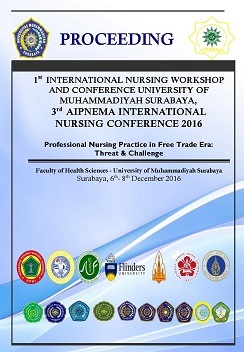Improving The Compliance Of Patients Type 2 DM To Foot Care With Health Belief Model Approach
Abstrak
Introduction: Diabetes Mellitus (DM) is a chronic disease if uncontrolled can cause acute and chronic complications that result in disability and even death. Compliance in foot care has an important role in the therapeutic management of patients with DM. The purpose of this study was to identify affecting Health Belief Model to improve the compliance of patients Type 2 DM to foot care. Method: The research design was correlations with cross sectional approach, conducted on 72 patients with Type 2 DM that managed by Prolanis in Ponorogo. Result: The results showed that perception of seriousness (p value 0.014), and the perception of benefits (p value 0.025) significantly influence the compliance of patients with Type 2 DM to foot care (α = 0.05). Conclusion: Health belief model is an effective effort to improve compliance to foot care, so as to prevent disability and death in patients with type 2 DM. Keywords: Compliance, Type 2 DM, Foot Care, Health Belief ModelReferensi
Askandar Tjokroprawiro. (1999). Hidup Sehat Bersama Diabetes. Gramedia. Jakarta. ISBN978-979-22-6348-0
Cunha, BA. (2005). Diabetic Foot Infection. http//www.emedecine.com/med/
Degresi. (2005). Ilmu perilaku Manusia. Jakarta. Rineka Cipta.
Glandz, Riner & Lewis. (2008). Health Behaviour and Health Education: Theory, research and Practice. 3 ed. San Fransisco: Josey-Bass Publiser.
International Diabetes Federation, 2015 Seventh edition, 2015 ISBN: 978-2-930229-81-2. www.diabetesatlas.org Diakses pada 26 Oktober 2015
International Diabetes Federation. (2012). One Adult In Ten Will Have Diabetes By 2030. http://www.idf.org/media-events/press-releases/2012/diabetes-atlas-5th-edition. Diunduh pada 3 April 2015 pukul 22.15 WIB.
Lipsky BA, Amstrong DG, Citron DM, Tice AD, Morgestern DE, AbrahamMA (2005). Ertapenem versus piperacillin/tazobactam for diabetic foot infections (SIDESTEP): prospective, randomized, controlled, double-blinde, multicentre trial. Lancet; 366, 1695-1703
Morisky DE, Ang A, Krousel-Wood M, ward H., (2008). Predictive Validity of a Self Medication adherence Measure for Hypertension Control. Journal of Clinical Hypertension.
Notoatmojo, S. (2010). Ilmu Perilaku Kesehatan. Jakarta: Rineka Cipta.
Purwanti LE. 2014. Hubungan Motivasi Dan Efikasi Diri Pasien DM Tipe 2 Dalam Melakukan Perawatan Kaki. Gaster. Vol. XI/No. 21/Februari 2014
Rosenstock IM.(1974). Historicalorigin of Health Belief Model. Health educator. Philadelpia: Elsevier Mosby. topic3547.htm. diakses tanggal 22 Januari 2012.
Waspadji, S. 2009. Kaki diabetes. In A. W. Sudoyo, B. Setiyohadi, I. Alwi,M. S K & S. Setiati (Eds V), Buku ajar ilmu penyakit dalam. Jakarta: Interna Publising






